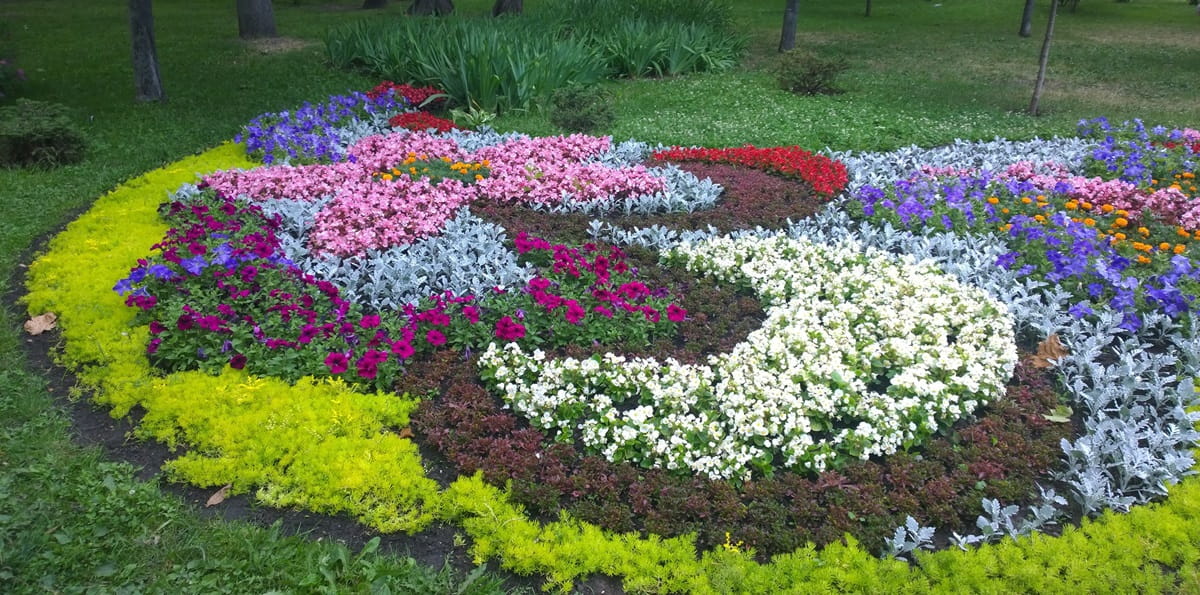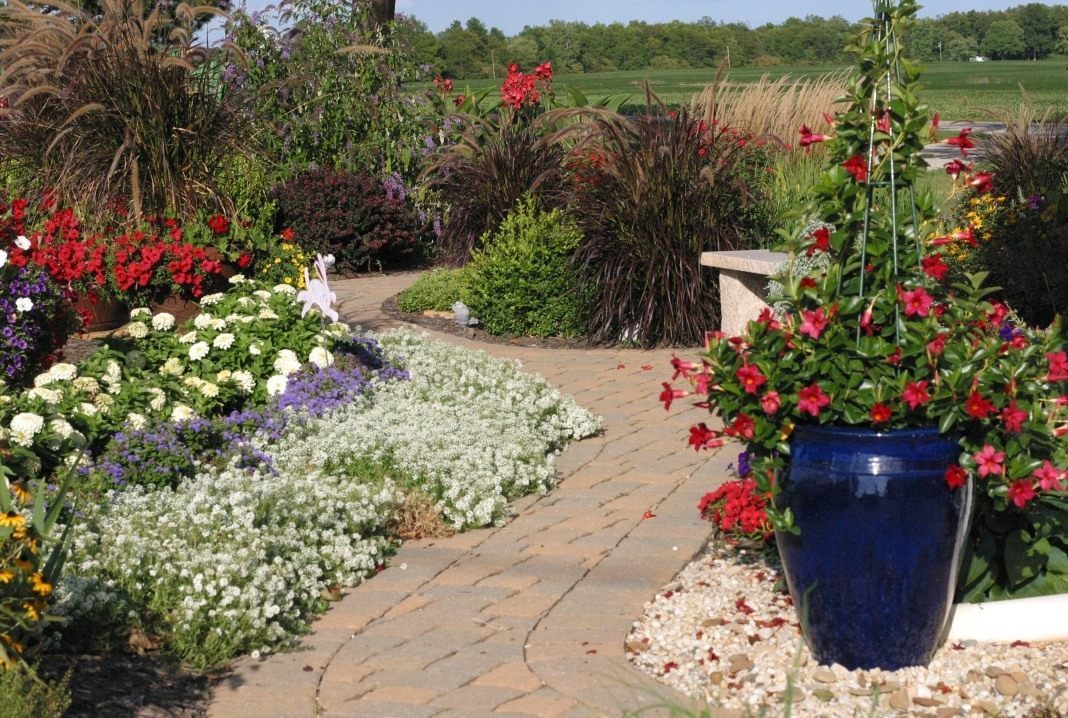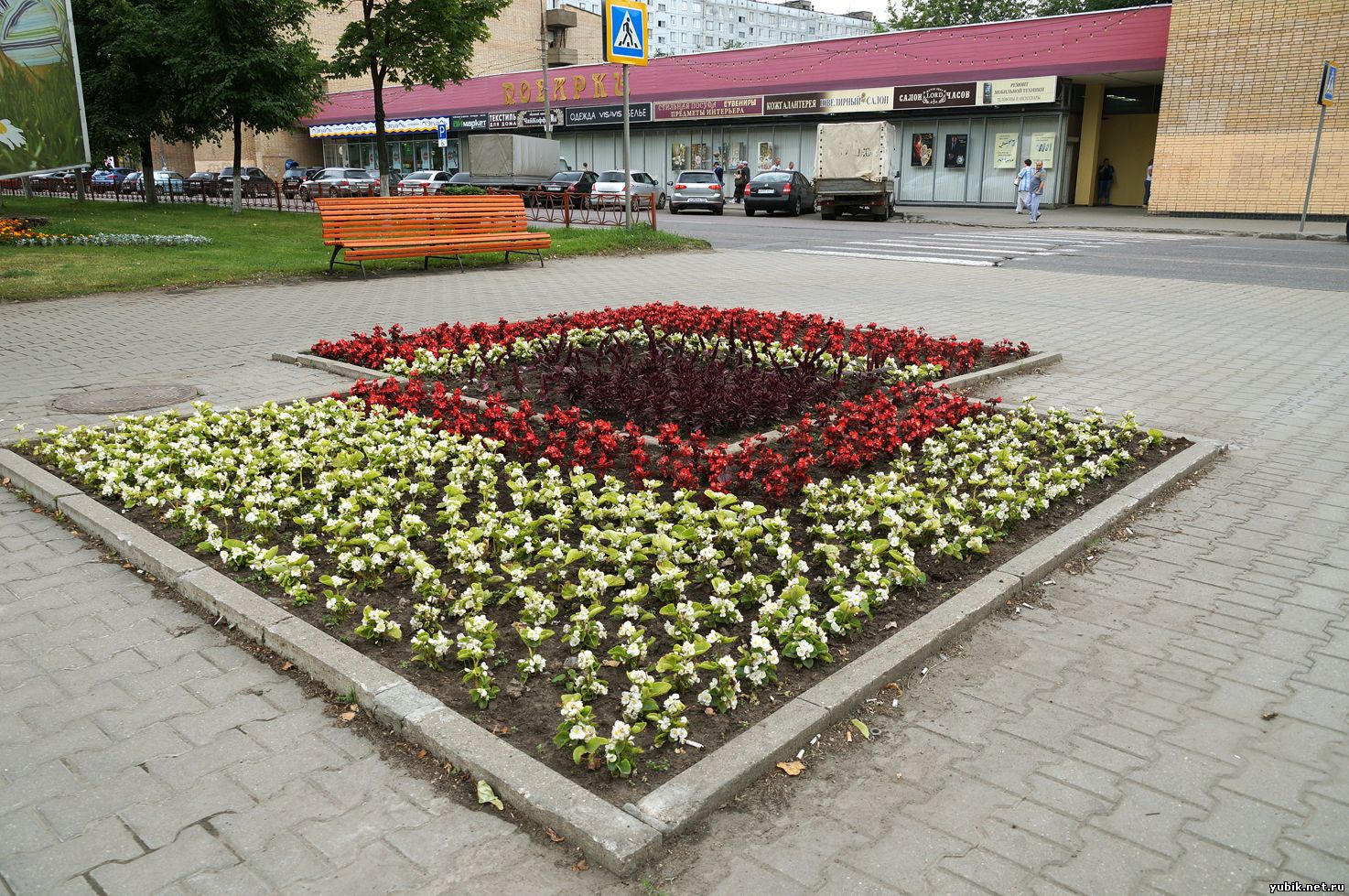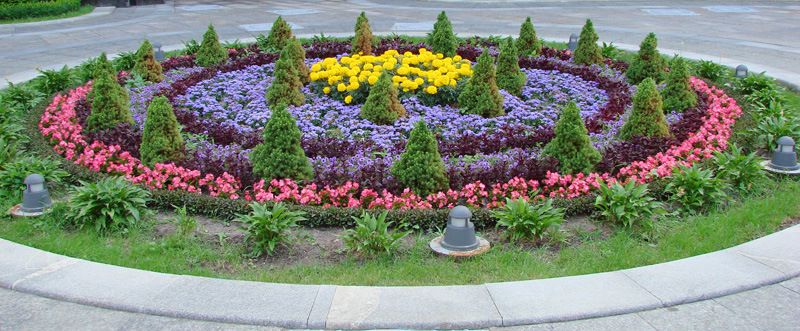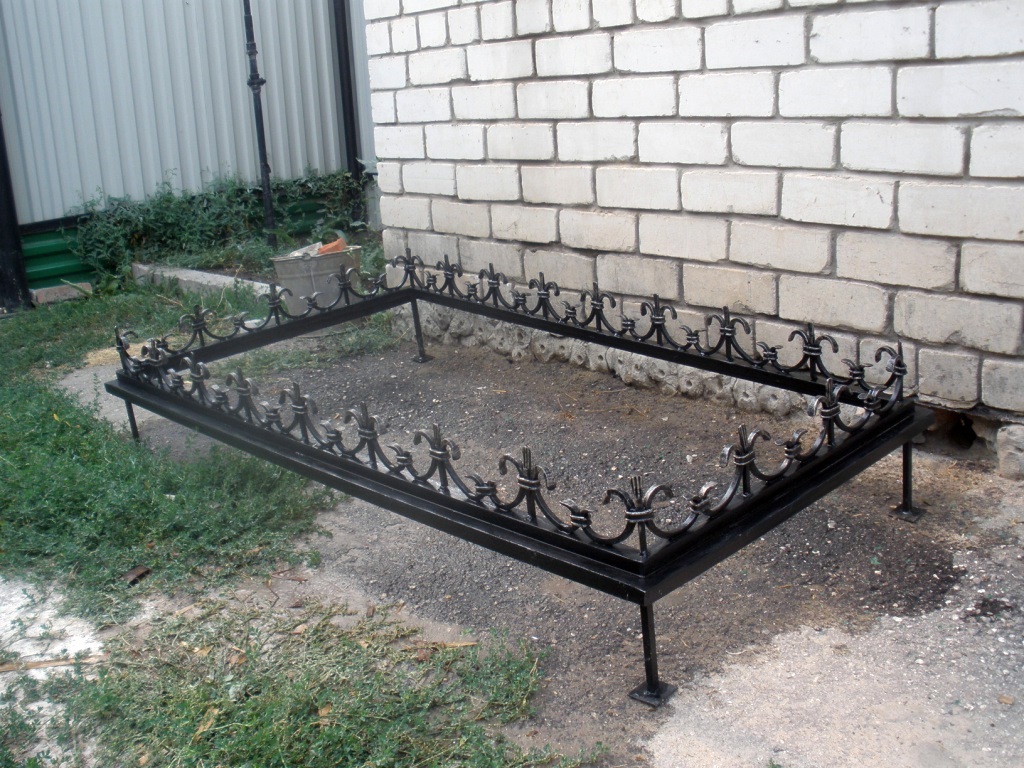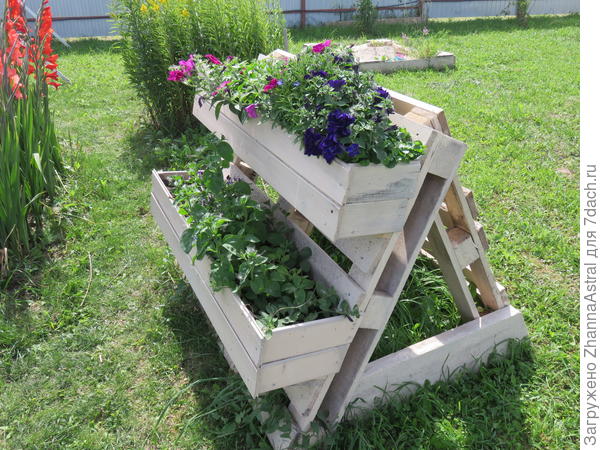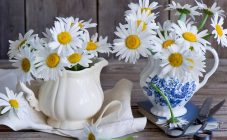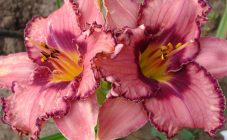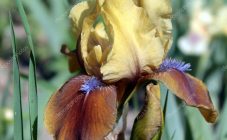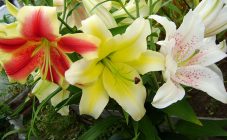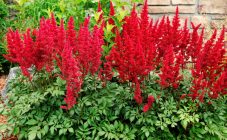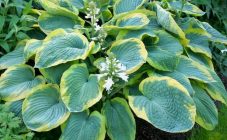Content:
- The basics of landscape design
- Plot style selection
- Drawing construction
- Flower bed around the apple tree
- Flower garden along the path
- Rectangular flower bed
- Square flower bed
- Crushed stone flower bed
- Wrought iron flower beds on the windows
- Round flower bed of perennials
- Corner flower bed
- Flower beds from cylinders
- Flower beds
- Galvanized flower beds
- Wrought iron flower beds
- Frame flower beds
- Slate flower bed
- Flowerbeds from boxes
- Triangular flower beds
- Flower garden from flower pots
- Clay flower garden
- Tall flower beds
- Beds for partial shade
- Small flower beds
- Flowerbed on the lawn
- Flower beds in the English style
- Flowerbed in the form of a basket with your own hands
- Country style flower garden
- Pallet flower garden
- How to separate a flower bed from a lawn
- Colored chips for flower beds
- How to paint sawdust for a flower bed
- How to properly fill a flower bed with chips
Landscape design is based on the creation of a new landscape from natural elements. Calling a designer guarantees a high-quality work, but it is a very expensive service. You can save money by knowing the basic principles of redevelopment.
The basics of landscape design
Plot style selection
Before reshaping the site, you should decide on the future style. Constant use of space or occasional events on the site lay the foundation for functionality.
Landscapes for permanent residence must be carefully calculated. When used as a temporary pastime, you can equip the site in a style that is as close to natural conditions as possible.
When choosing a style of strict order, a symmetrical layout of geometric shapes will organically look. For this, straight alleys, trimmed hedges, composite flowering beds are suitable.
To create coziness, you can take a rural theme as a basis. Low-maintenance plants, herbaceous winding paths, wooden decorative elements, hedges and partitions entwined with greenery will cope with this role.
When choosing an urban style, accents can be placed with building structures in the form of arches, gazebos, cobbled areas. This design emphasizes the outstanding features of trees and shrubs.
Drawing construction
After choosing a garden style, the next step is to take measurements and build a drawing. On the map of the site, it should be noted the available features of the relief (irregularities, depressions, rises). Attention should be paid to changes in light conditions during the day. You should decide in advance on the parts to be left, be it stumps, rubble, trees or bushes.
The data obtained should be displayed on graph paper in the form of a diagram at a scale of 1: 100 or 1:50, displaying the existing buildings and saved parts.
When choosing the location of decorative elements, one should start from the location of neighboring houses, the presence of paths or reservoirs and the relief of the site.
To visually increase the size of the site, you can make a lawn covering the entire available width. The zig-zag or diagonal layout of the track creates the illusion of a wide area. Covering the boundaries of the site with shrubs or trees, you can create local shading without overloading the site.
After approval of the site plan, the terrain should be marked. At the same time, the choice of flora and decor should be checked against the terrain and the level of illumination.In the far corners of the garden, it is better to place unpretentious shade-loving plants, while flower arrangements will look good in open places.
Types of flower beds
When creating decorative compositions, various types of flower beds are popular. Among them, the most common are:
- Mixborder is a mixed type of border. A flower garden with an irregular elongated shape. It is preferable to plant plants in this form, providing continuous flowering;
- Border - narrow elongated flower beds made of small plants. Curbs act as zone delimiters;
- Rabatka is a kind of rectangular flower garden placed along the paths. You can often find a rabatka located along the walls of the building;
- Arabesques are complex geometric patterns collected from minerals and flowers, located in the central part of the garden or in a spacious open space;
- A flower bed is a flower garden of the correct shape from one - and biennial contrastingly colored flowers;
- Flowerpot - a way of decorating annual plants in places not intended for the installation of flower beds (asphalt areas, an open terrace, a patio);
- Rokkari - a rocky hill made of crushed stone or sandstone, designed to decorate perennial conifers;
- The coast of the reservoir - a flower garden formed from plants of near-water species, in the immediate vicinity of the reservoir;
- A rose garden is a flower garden consisting of a variety of roses. Due to the exactingness of roses to growing conditions, it is better to choose a place that allows you to completely cover the planting for the winter;
- Heather flower garden - compositions of heather species, located in shady areas on acidic soils.
Self-made flower bed options
To create a flower garden, it is not always possible to call a specialist in landscape design. You can save money by making your own flower beds. To do this, you must have basic knowledge of plant and fence selection options.
Flower bed around the apple tree
The choice of an apple tree as the central element of a flower bed is determined by its characteristics. It gives plants a diffused shade, protecting them from direct sunlight. In addition, the soil composition allows the growing of most ornamental plants. A flower bed around the apple tree, blooming with bright plants, will allow you to beautifully arrange the space near the trunk. Periwinkle, nasturtium, bells, daffodils or daisies will give the flower bed around the apple tree a decorative look.
Flower garden along the path
Placing a long narrow flower bed along the paths allows you to arrange a small garden in which there is no room for a separate flower garden. The bed copes well with this role, both two- and one-sided. The combination of evergreens with flowering lush plants will give the paths an elegant look.
Rectangular flower bed
Rectangular flower beds include a rabatka, a type of flower bed located along the paths. With its help, you can create multi-tiered compositions or shield a small rectangular reservoir with it. Rabatka is one of the versatile solutions for large spaces.
Square flower bed
A universal classic composition for all styles and shapes of sites. Looks good around the house, imitating its outlines, and in the adjacent territory, emphasizing the overall style.
Crushed stone flower bed
Do-it-yourself crushed stone beds allow you to take off the hassle of weeding weeds. Crushed stone goes well with bright colors, and the ability to choose the color of crushed stone allows you to give a more decorative look. Among other things, crushed stone is a cheap and environmentally friendly material that does not interfere with the air exchange of the root system.
Wrought iron flower beds on the windows
To make the window openings decorative, you can resort to the help of forged window flower girls.Refining the walls, creating a more attractive look, you can pick up a forged element, both for an apartment and for a country house. Forged flower beds are not affected by precipitation, allow you to expose flower pots at a distance from the window frame.
Round flower bed of perennials
The easiest way to decorate a flower bed is considered to be perennials of continuous flowering. A round flower bed of continuous flowering perennials allows you to experiment with flower shapes. Flowers of different sizes look good in row growing.
Corner flower bed
To create corner beds, it is better to choose shade-loving plants. The design of the corners of the site or waste storage sites can be done with the help of evergreen shrubs that are unpretentious in care. Having fenced such a flower bed with a brick or stone, you can not be afraid of excessive growth of plants.
Flower beds from cylinders
An interesting solution is the fencing of the flower bed with cylinders or bottles. This is one of the cheapest ways to decorate flowers. The choice of multi-colored and different sized elements will create a unique look.
Flower beds
The metal is able to fit into any style of the site, be it a wicker structure or a solid metal sheet. Such material is durable and environmentally friendly. It can be decorated by repainting to match the overall composition.
Galvanized flower beds
Galvanized flower beds can be used both in the open field and in greenhouse conditions. Polymer-coated galvanized elements are often used as fences for curbs, flower beds and flower beds.
Wrought iron flower beds
Forged metal is distinguished by its durability and the ability to create an individual exclusive look of the flowerbed. Durable elements allow you to create multi-tiered street flower arrangements. The supports themselves do not require any special maintenance.
Frame flower beds
Any material (wood, metal, plastic) can be used as a frame, to which flowerpots with flowers are attached. With the help of frames, you can create various types of decorative elements.
Slate flower bed
Fencing a flower bed with slate refers to the budget options. However, there is a need to fasten the joints of such a fence. In addition, slate is a fragile and brittle material that requires accuracy.
Flowerbeds from boxes
Boxes are suitable for creating small flower beds. They can be installed in places where it is impossible to place a full-fledged flower garden. The advantage of wooden boxes is their environmental friendliness. Plastic boxes are considered more durable.
Triangular flower beds
They look good on angular areas. It is optimal to use herbaceous perennial plants, fenced off by a rocky fence.
Flower garden from flower pots
You can add novelty to a flower bed using painted flower pots. In addition, they can be stacked at different levels. The idea of using pots allows for transportable compositions.
Clay flower garden
Broken clay pots can be used as zoning for small flower beds. Small fragments - as protection against excess moisture. The shards can be used as markers for planting in your garden by labeling them.
Tall flower beds
These are compact flower beds that give a chance to plant the right plants in the wrong conditions. You can create the necessary drainage layer by decorating several tiers of flowers. The variety of materials allows you to choose a design that fits into the overall style.
Beds for partial shade
In partial shade of the crown of trees or with general shade of the site, you should pay attention to shade-tolerant plants. Balsam, scented tobacco, mimulus, mertensia can beautify shaded areas.
Small flower beds
The most popular type of flower bed for areas with little free space.Small flower beds in the shape of a circle are easy to maintain, easily assembled from scrap materials (tire, stump).
Flowerbed on the lawn
Any shape of the flower bed can be chosen, taking into account the general style, atmosphere and decoration of the garden. The main work is to limit the contours of the flower garden from the lawn. As a frame, you can use metal strips, plastic or natural stone.
Flower beds in the English style
The English style is about creating park hills and paths between them. Arches, hedges, artificial ponds are also elements of this style. The abundance of flowers and greenery around the house will help give the site an English style.
Flowerbed in the form of a basket with your own hands
A basket flower bed allows you to add variety to your garden. For weaving a basket, it is optimal to choose hazel, birch, willow, dogwood or another kind of tree that is flexible. After removing the bark from the rods, they should be moistened with water before work to make them more flexible. In addition to wooden rods, you can use old tires by cutting off one side and placing it on a stand.
Country style flower garden
The rustic landscape style is a success for the vibrant yellow-red color of the plants. Such flower beds are often used to decorate playgrounds. Characteristic features of the country style in the application of architectural elements of village life (carts, scarecrows, pots).
Pallet flower garden
Pallets or pallets are used for vertical landscaping. Pallet beds lend a rustic style to the composition. By assembling the frame and fixing several pallets on it, you can create a small floral arrangement.
How to separate a flower bed from a lawn
You can separate the lawn from the flower garden by laying paving slabs, brick or stone between them. In addition, you can pour a concrete fence.
Wooden beams can be used as a limitation on areas with straight lines, especially when decorating different levels of the cottage.
The materials remaining after the repair in the form of tiles or decorative stone can be used as a fence for flower beds.
Colored chips for flower beds
Decorative wood chips are often used for garden decoration. It is a safe and environmentally friendly material. You can use different colored wood chips to create a dramatic look.
How to paint sawdust for a flower bed
It doesn't take much work to stain the sawdust. It is necessary to choose the desired color using the color scheme. Dilute an aqueous solution of stain with color in a bowl and paint over sawdust in it. After that, thoroughly dry the resulting material in a previously prepared area.
How to properly fill a flower bed with chips
For a longer-term filling of the site with chips, it should be laid on a layer of agrospan (covering material). In this form, 3-4 cm of chips are required. In the absence of a covering material, the thickness of the chip layer must be doubled. To give freshness to the site, the chips should be renewed every season, replacing the top layer. The lower one will rot over time, fertilizing the soil.
In conclusion, we can say that making a garden yourself is a fun process. However, it requires careful preparation, from choosing a style and taking measurements, to drawing up flower arrangements based on the existing features of the relief and climate.
